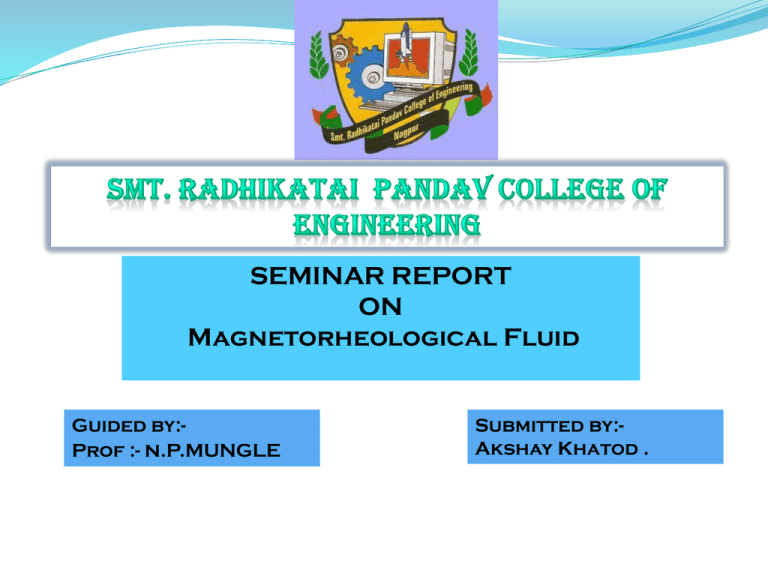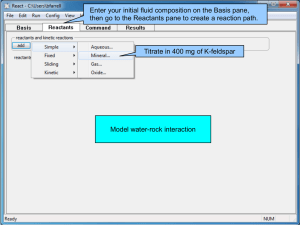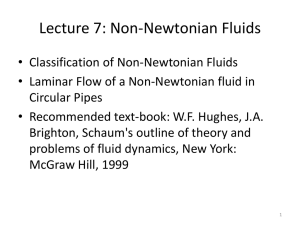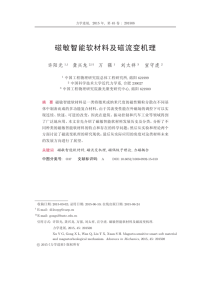File - Vigyan Pariyojana
advertisement

SEMINAR REPORT ON Magnetorheological Fluid Guided by:Prof :- n.P.MUNGLE Submitted by:Akshay Khatod . Introduction Controllable fluids are materials that respond to an external excitation field. When exposed to an electric or magnetic field, their rheological behavior exhibits remarkable changes. Theses martmaterials are commonly referred to as, 1. Magnetorheological (MR) fluids, 2. Electrorheological (ER) fluids, 3. Ferro (FR) fluids. Introduction to MR Fluid A magnetorheological fluid (MR fluid) is a type of smart fluid in a carrier fluid, usually a type of oil. When subjected to a magnetic field, the fluid greatly increases its apparent viscosity, to the point of becoming a viscoelastic solid. Importantly, the yield stress of the fluid when in its active ("on") state can be controlled very accurately by varying the magnetic field intensity. History William Kordonski was inventor of MR Fluid. In 1974, William started work on magnetorheological (MR) fluids, which are suspensions of micron-size ferromagnetic particles, such as iron, in fluids such as oil or water. William I. Kordonski, Inventor of MR Fluid. How it works The magnetic particles, which are typically micrometer or nanometer scale spheres or ellipsoids, are suspended within the carrier oil are distributed randomly and in suspension under normal circumstances, as below. When a magnetic field is applied, however, when the fluid is contained between two poles , the resulting chains of particles restrict the movement of the fluid, perpendicular to the direction of flux, effectively increasing its viscosity. Modes of operations An MR fluid is used in one of three main modes of operation, these being flow mode, shear mode and squeezeflow mode. 1. Flow mode Flow mode, is one of the operating modes in the MR devices where the flow of the MR fluid between motionless plates or an orifice is created by a pressure drop. 2. Shear mode An MR fluid is situated between two surfaces, whereby only one surface slides or rotates in relation to the other, with a magnetic field applied perpendicularly to the direction of motion of these shear surfaces. 3. Squeeze-flow mode Squeeze mode operates when a force is applied to the plates in the same direction of a magnetic field to reduce or expand the distance between the parallel plates causing a squeeze flow. Advantages •Have higher magnitude of yield stress. •Compared to ER fluids the simple construction of devices, low power requirements for control, fast response. • The squeeze mode of a MR damper has significant advantages such as simple structure, clear effectiveness and quick response. •The fluids also have the advantages of using low voltage power supplies in the range of 2 to 25 V, with current range between 1 to 2 Amps and power ratings between 2-50 watts. Disadvantages •High density, due to presence of iron, makes them heavy. However, operating volumes are small, so while this is a problem, it is not insurmountable. •High-quality fluids are expensive. •Fluids are subject to thickening after prolonged use and need replacing. •Settling of Ferro-particles can be a problem for some applications. Application 1.Mechanical engineering Magnetorheological dampers these dampers are mainly used in heavy industry with applications such as heavy motor damping, operator seat/cab damping in construction vehicles, and more. 2.Military and defense The U.S. Army Research Office is currently funding research into using MR fluid to enhance body armor. 3.Optics Magnetorheological finishing a magnetorheological fluid-based optical polishing method, has proven to be highly precise. 4.Automotive The MR sponge clutch may be used to provide launch control of an automobile thereby achieving smooth vehicle launch. The MRF clutch thus may replace the existing torque converters and therefore help increase the fuel economy. Schematic of a cylindrical MR Clutch 5.Aerospace Magnetorheological dampers are under development for use in military and commercial helicopter cockpit seats, as safety devices in the event of a crash. When no magnetic field, low viscosity of MR fluid When magnetic field applied, high viscosity of MR fluid Conclusion Relatively new technology has caught on quickly and is replacing century-old methods for developments. Used not only in typical machined applications, but in house hold things and many industries. As material and industrial technology advances faster , longer component life and good products will be achievable. References www.wikipedia.org/magneticfluid.index. www.powershow.com/magnetorheologicalfluid.ppt/ Article: (History of Magnetorheological Finishing Daniel C. Harris, Naval Air Systems Command). (THE BEHAVIOUR OF MAGNETORHEOLOGICAL LUIDS IN SQUEEZE MODE By SAIFUL AMRI BIN MAZLAN, School of Mechanical and Manufacturing Engineering Faculty of Engineering and Computing ,Dublin City University)







![REFERENCES [1] Bossis, G., Lacis, S., Meunier, A. and Volkova, O. Magnetorheological](http://s2.studylib.net/store/data/014530042_1-07003635930b4c35e424edc35afafc8b-300x300.png)
